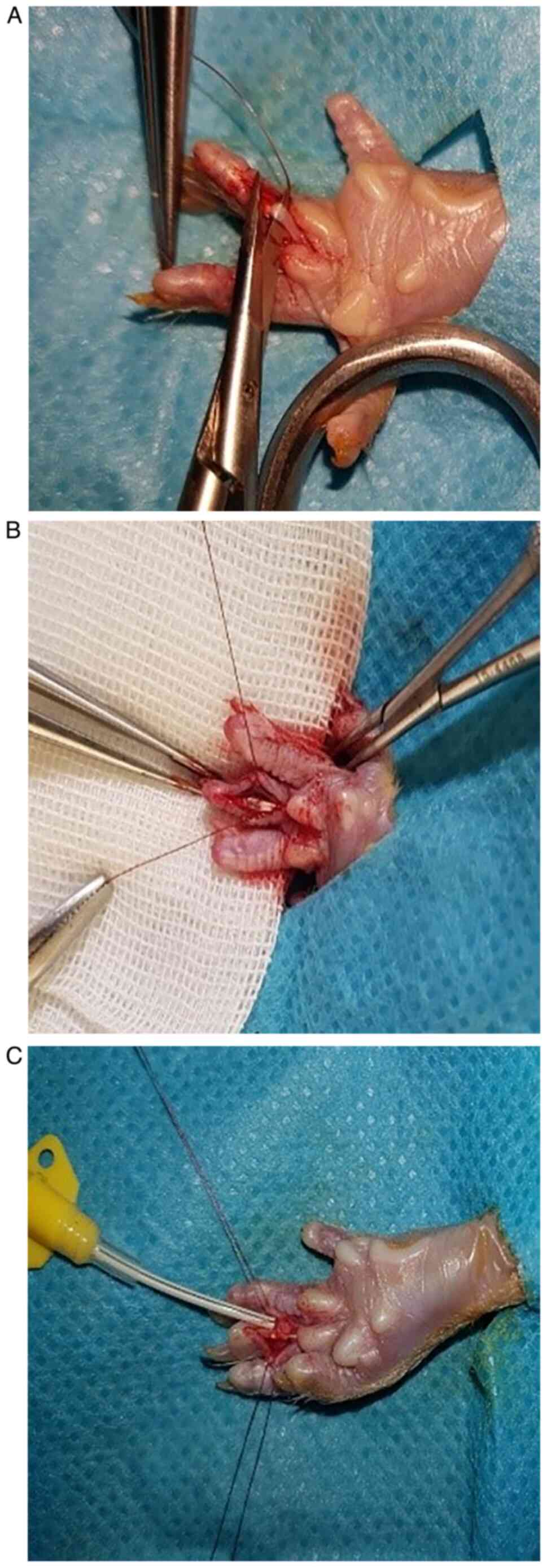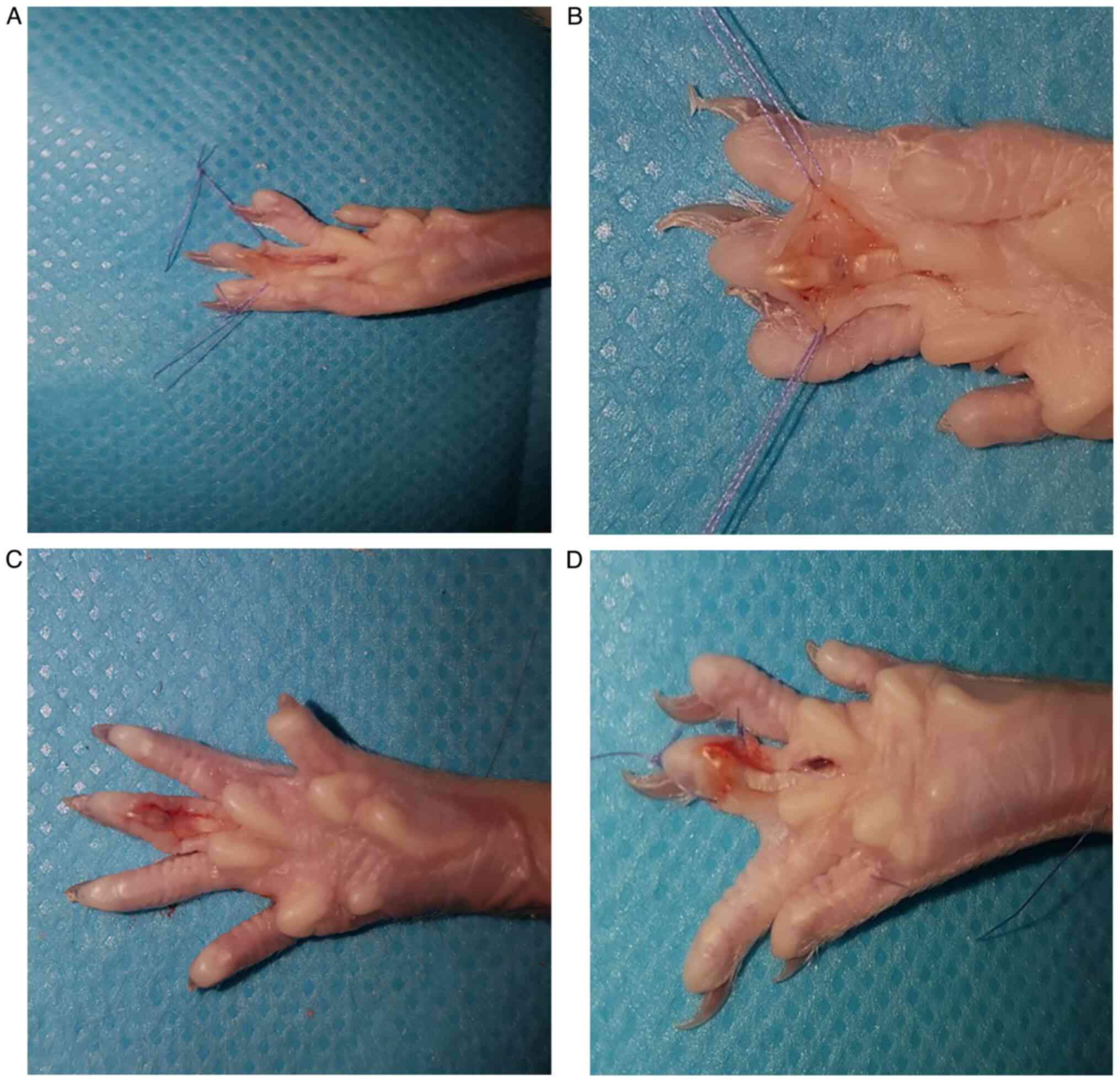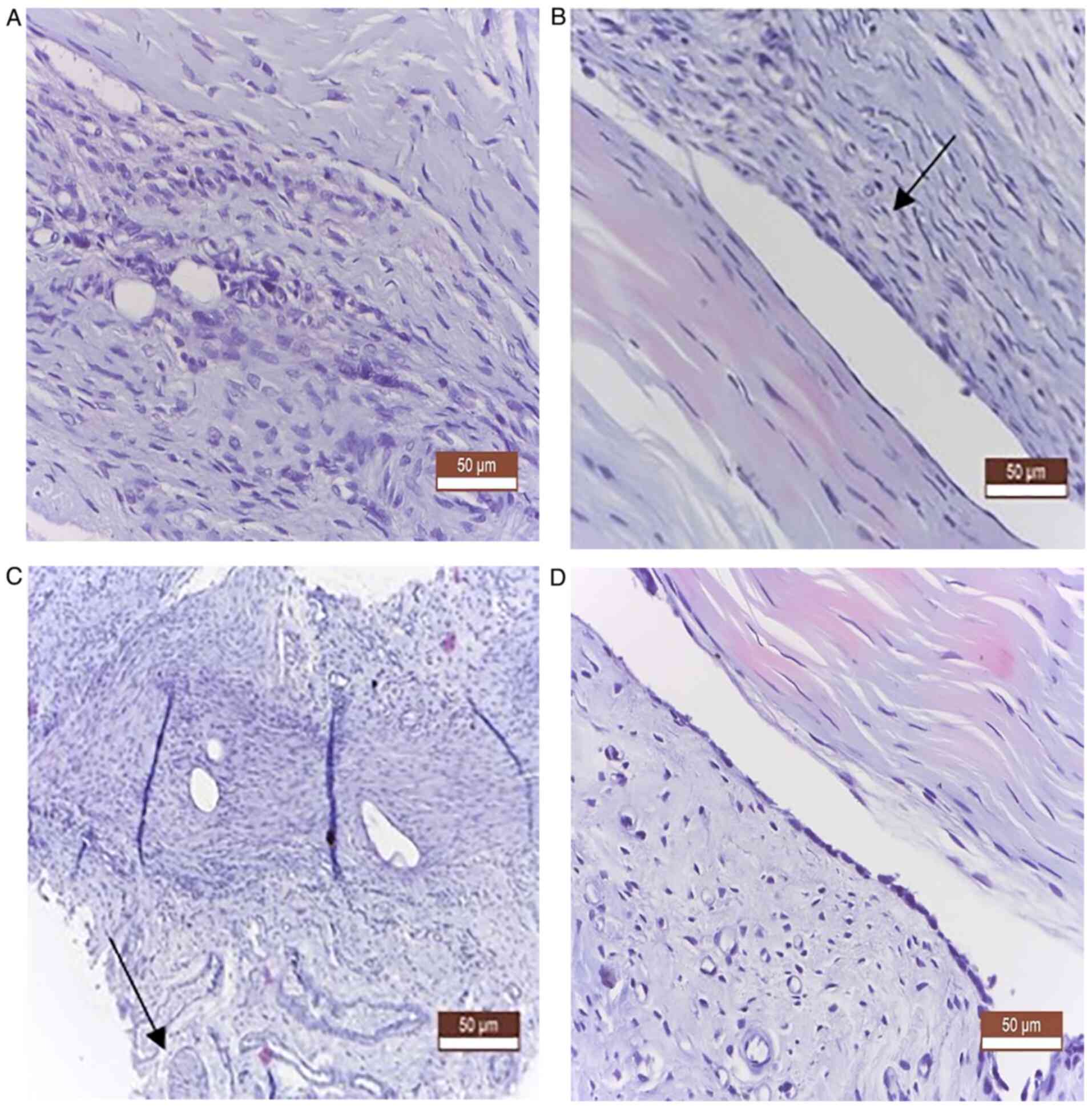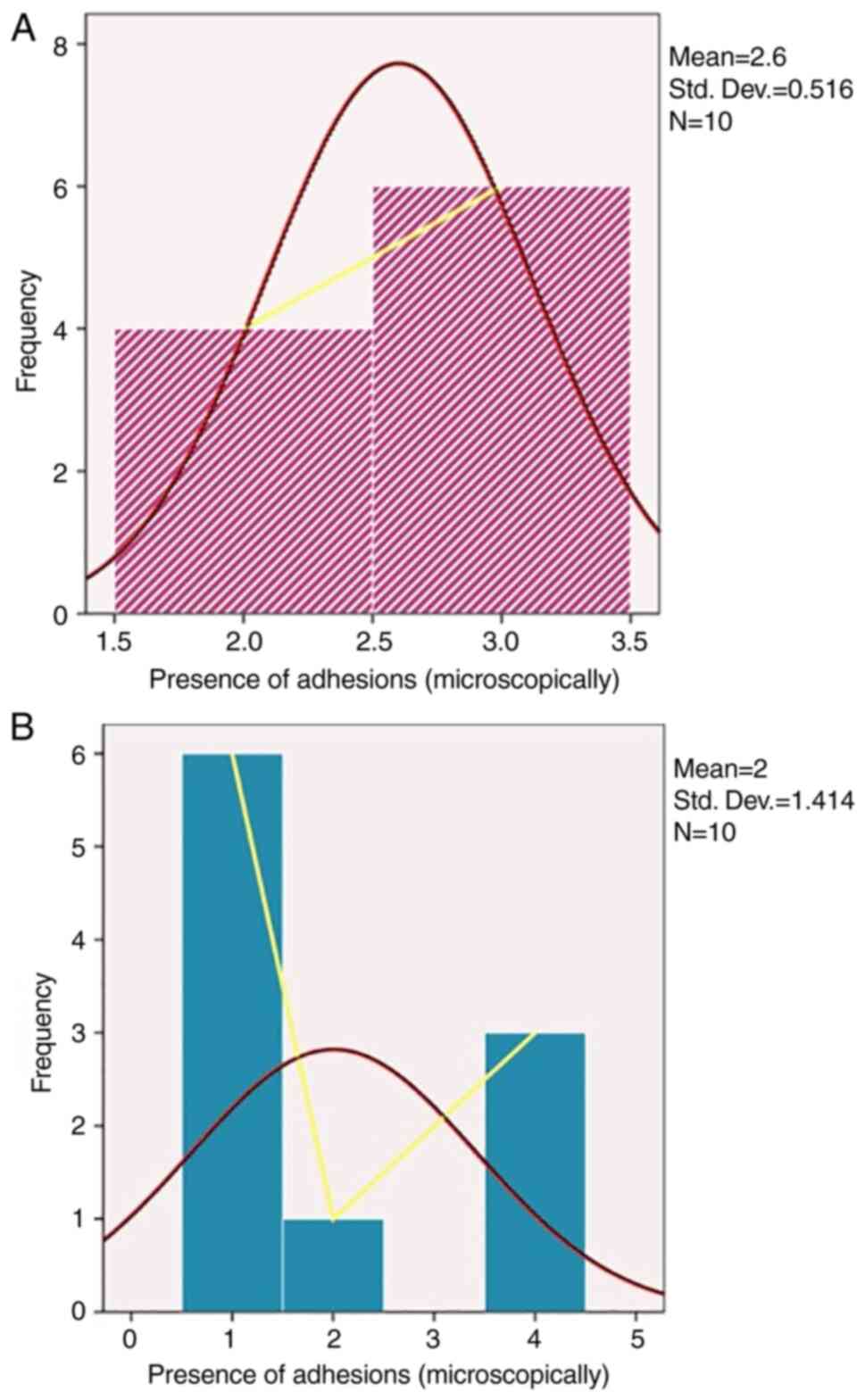|
1
|
Chen CH, Chen SH, Shalumon KT and Chen JP:
Prevention of peritendinous adhesions with electrospun polyethylene
glycol/polycaprolactone nanofibrous membranes. Colloids Surf B
Biointerfaces. 133:221–230. 2015.PubMed/NCBI View Article : Google Scholar
|
|
2
|
de Jong JP, Nguyen JT, Sonnema AJ, Nguyen
EC, Amadio PC and Moran SL: The incidence of acute traumatic tendon
injuries in the hand and wrist: A 10-year population-based study.
Clin Orthop Surg. 6:196–202. 2014.PubMed/NCBI View Article : Google Scholar
|
|
3
|
Wu YF and Tang JB: Tendon healing, edema,
and resistance to flexor tendon gliding: Clinical implications.
Hand Clin. 29:167–178. 2013.PubMed/NCBI View Article : Google Scholar
|
|
4
|
Sammer DM and Chung KC: Advances in the
healing of flexor tendon injuries. Wound Repair Regen. 22 (Suppl
1):S25–S29. 2014.PubMed/NCBI View Article : Google Scholar
|
|
5
|
Loiselle AE, Kelly M and Hammert WC:
Biological augmentation of flexor tendon repair: A challenging
cellular landscape. J Hand Surg Am. 41:144–149. 2016.PubMed/NCBI View Article : Google Scholar
|
|
6
|
Giesen T, Calcagni M and Elliot D: Primary
flexor tendon repair with early active motion: Experience in
Europe. Hand Clin. 33:465–472. 2017.PubMed/NCBI View Article : Google Scholar
|
|
7
|
Evans RB: Managing the injured tendon:
Current concepts. J Hand Ther. 25:173–190. 2012.PubMed/NCBI View Article : Google Scholar
|
|
8
|
Moro-oka T, Miura H, Mawatari T, Kawano T,
Nakanishi Y, Higaki H and Iwamoto Y: Mixture of hyaluronic acid and
phospholipid prevents adhesion formation on the injured flexor
tendon in rabbits. J Orthop Res. 18:835–840. 2000.PubMed/NCBI View Article : Google Scholar
|
|
9
|
Sun Y, Chen MY, Zhao C, An KN and Amadio
PC: The effect of hyaluronidase, phospholipase, lipid solvent and
trypsin on the lubrication of canine flexor digitorum profundus
tendon. J Orthop Res. 26:1225–1229. 2008.PubMed/NCBI View Article : Google Scholar
|
|
10
|
Taguchi M, Zhao C, Sun YL, Jay GD, An KN
and Amadio PC: The effect of surface treatment using hyaluronic
acid and lubricin in the gliding resistance of human extrasynovial
tendons in vitro. J Hand Surg Am. 34:1276–1281. 2009.PubMed/NCBI View Article : Google Scholar
|
|
11
|
Oryan A, Moshiri A and Meimandiparizi AH:
Effects of sodium-hyaluronate and glucosamine-chondroitin sulfate
on remodeling stage of tenotomized superficial digital flexor
tendon in rabbits: A clinical, histopathological, ultrastructural,
and biomechanical study. Connect Tissue Res. 52:329–339.
2011.PubMed/NCBI View Article : Google Scholar
|
|
12
|
Rhee DK, Marcelino J, Baker M, Gong Y,
Smits P, Lefebre V, Jay GD, Stewart M, Wang H, Warman ML and
Carpten JD: The secreted glycoprotein lubricin protects cartilage
surfaces and inhibits synovial cell overgrowth. J Clin Invest.
115:622–631. 2005.PubMed/NCBI View
Article : Google Scholar
|
|
13
|
Amadio PC: Gliding resistance and
modifications of gliding surface of tendon: Clinical perspectives.
Hand Clin. 29:159–166. 2013.PubMed/NCBI View Article : Google Scholar
|
|
14
|
St Onge R, Weiss C, Denlinger JL and
Balazs EA: A preliminary assessment of Na-hyaluronate injection
into ‘no man's land’ for primary flexor tendon repair. Clin Orthop
Relat Res. 146:269–275. 1980.PubMed/NCBI
|
|
15
|
Amiel D, Ishizue K, Billings E Jr, Wiig M,
Vande Berg J, Akeson WH and Gelberman MD: Hyaluronan in flexor
tendon repair. J Hand Surg Am. 14:837–843. 1989.PubMed/NCBI View Article : Google Scholar
|
|
16
|
Hayashi M, Zhao C, Thoreson AR, Chikenji
T, Jay GD, An KN and Amadio PC: The effect of lubricin on the
gliding resistance of mouse intrasynovial tendon. PLoS One.
8(e83836)2013.PubMed/NCBI View Article : Google Scholar
|
|
17
|
Zhao C, Hashimoto T, Kirk RL, Thoreson AR,
Jay GD, Moran SL, An KN and Amadio PC: Resurfacing with chemically
modified hyaluronic acid and lubricin for flexor tendon
reconstruction. J Orthop Res. 31:969–975. 2013.PubMed/NCBI View Article : Google Scholar
|
|
18
|
Zhao C, Sun YL, Kirk RL, Thoreson AR, Jay
GD, Moran SL, An KN and Amadio PC: Effects of a lubricin-containing
compound on the results of flexor tendon repair in a canine model
in vivo. J Bone Joint Surg Am. 92:1453–1461. 2010.PubMed/NCBI View Article : Google Scholar
|
|
19
|
Kitano T, Zerwekh JE, Edwards ML, Usui Y
and Allen MD: Viscous carboxymethylcellulose in the prevention of
epidural scar formation. Spine (Phila Pa 1976). 16:820–823.
1991.PubMed/NCBI View Article : Google Scholar
|
|
20
|
Fransen P: Safety of
carboxymethylcellulose/polyethylene oxide for the prevention of
adhesions in lumbar disc herniation-consecutive case series review.
Ann Surg Innov Res. 2(2)2008.PubMed/NCBI View Article : Google Scholar
|
|
21
|
Rodgers KE, Robertson JT, Espinoza T,
Oppelt W, Cortese S, diZerega GS and Berg RA: Reduction of epidural
fibrosis in lumbar surgery with Oxiplex adhesion barriers of
carboxymethylcellulose and polyethylene oxide. Spine J. 3:277–284.
2003.PubMed/NCBI View Article : Google Scholar
|
|
22
|
Gill C, Klufmoeller F and Noack W:
Experience with Oxiplex/SP gel for the prevention of post-surgical
adhesions in decompressive spine surgery. Paper presented at North
American Spine Society 18th Annual Meeting. October 21-25, San
Diego, CA, 2003.
|
|
23
|
Tos P, Crosio A, Pellegatta I, Valdatta L,
Pascal D, Geuna S and Cherubino M: Efficacy of anti-adhesion gel of
carboxymethylcellulose with polyethylene oxide on peripheral nerve:
Experimental results on a mouse model. Musce Nerve. 53:304–309.
2016.PubMed/NCBI View Article : Google Scholar
|
|
24
|
Balls M, Goldberg A, Fentem J, Broadhead
CL, Burch RL, Festing MF, Frazier JM, Hendriksen CF, Jennings M,
van der Kamp MD, et al: The three Rs: The way forward: The report
and recommendations of ECVAM Workshop 11. Altern Lab Anim.
23:838–866. 1995.PubMed/NCBI
|
|
25
|
Savage R: The search for the ideal tendon
repair in zone 2: Strand number, anchor points and suture
thickness. J Hand Surg Eur Vol. 39:20–29. 2014.PubMed/NCBI View Article : Google Scholar
|
|
26
|
Strickland JW: The scientific basis for
advances in flexor tendon surgery. J Hand Ther. 18:94–111.
2005.PubMed/NCBI View Article : Google Scholar
|
|
27
|
Wong JKF, Lui YH, Kapacee Z, Kadler KE,
Fergusos MWJ and McGrouther DA: The cellular biology of flexor
tendon adhesion formation: An old problem in a new paradigm. Am J
Pathol. 175:1938–1951. 2009.PubMed/NCBI View Article : Google Scholar
|
|
28
|
Ozgenel GY: The effects of a combination
of hyaluronic and amniotic membrane on the formation of
peritendinous adhesions after flexor tendon surgery in chickens. J
Bone Joint Surg Br. 86:301–307. 2004.PubMed/NCBI View Article : Google Scholar
|
|
29
|
Khanna A, Friel M, Gougoulias N, Longo UG
and Maffulli N: Prevention of adhesions in surgery of the flexor
tendons of the hand: What is the evidence? Br Med Bull. 90:85–109.
2009.PubMed/NCBI View Article : Google Scholar
|
|
30
|
Loiacono C, Palermi S, Massa B, Belviso I,
Romano V, Gregorio AD, Sirico F and Sacco AM: Tendinopathy:
Pathophysiology, therapeutic options, and role of nutraceutics. A
narrative literature review. Medicina (Kaunas).
55(447)2019.PubMed/NCBI View Article : Google Scholar
|
|
31
|
Megerle K, Woon C, Kraus A, Raghavan S,
Pham H and Chang J: Flexor tendon sheath engineering using
decellularized porcine pericardium. Plast Reconstr Surg.
138:630e–641e. 2016.PubMed/NCBI View Article : Google Scholar
|
|
32
|
Linderman SW, Gelberman RH, Thomopoulos S
and Shen H: Cell and biologic-based treatment of flexor tendon
injuries. Oper Tech Orthop. 26:206–215. 2016.PubMed/NCBI View Article : Google Scholar
|
|
33
|
Ji X, Reisdorf RL, Thoreson AR, Berglund
LR, Moran SL, Jay JD, An KN, Amadio PC and Zhao C: Surface
modification with chemically modified synovial fluid for flexor
tendon reconstruction in a canine model in vivo. J Bone Joint Surg
Am. 97:972–978. 2015.PubMed/NCBI View Article : Google Scholar
|
|
34
|
Hagberg L, Heinegård D and Ohlsson K: The
contents of macromolecule solutes in flexor tendon sheath fluid and
their relation to synovial fluid. A quantitative analysis. J Hand
Surg Br. 17:167–171. 1992.PubMed/NCBI View Article : Google Scholar
|
|
35
|
Özgenel GY and Etöz A: Effects of
repetitive injections of hyaluronic acid on peritendinous adhesions
after flexor tendon repair: A preliminary randomized,
placebo-controlled clinical trial. Ulus Travma Acil Cerrahi Derg.
18:11–17. 2012.PubMed/NCBI View Article : Google Scholar
|
|
36
|
diZerega GS, Cortese S, Rodgers KE, Block
KM, Falcone SJ, Juarez TG and Berg R: A modern biomaterial for
adhesion prevention. J Biomed Mater Res B Appl Biomater.
81:239–350. 2007.PubMed/NCBI View Article : Google Scholar
|
|
37
|
Lei W, Ehmsen RJ, Chiaccherini RP, Krelle
JL and diZerega GS: Reduction of leg pain by Oxiplex gel after
lumbar discectomy in patients with predominant leg pain and
elevated levels of lower back pain: A prospective, randomized,
blinded, multicenter clinical study. J Spine Disord Tech.
28:301–307. 2015.PubMed/NCBI View Article : Google Scholar
|


















